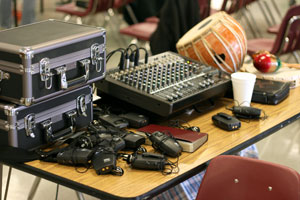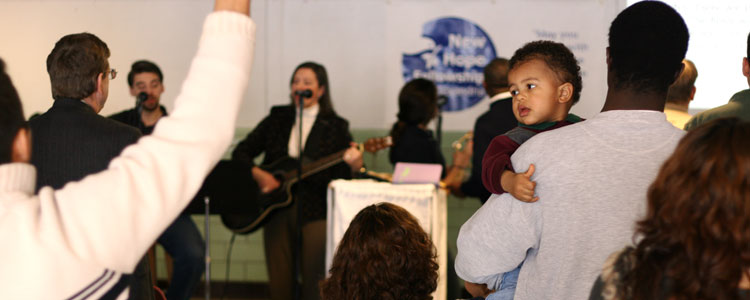I came to work with Franconia Conference with the understanding that I was going to be scouting into the future and working into it. That role for these last 18 months has included a lot of conversations and travel and has evolved beyond scouting in many ways. However, after listening, engaging, traveling and writing, I believe that I am glimpsing into our shared future. In many ways what I have come to understand came through clearly in snapshots of a weekend visit in Washington, DC and Harrisonburg, VA in February.
 These snapshots have literally kept me awake at night for the last weeks, wondering and imagining how we might get there and yet knowing that we’re already on the road whether we admit it or not. It’s a future that excites me and forces me to think and rethink, to struggle and embrace the moments of hope that manifest along the way. It’s a future that in many ways is already here.
These snapshots have literally kept me awake at night for the last weeks, wondering and imagining how we might get there and yet knowing that we’re already on the road whether we admit it or not. It’s a future that excites me and forces me to think and rethink, to struggle and embrace the moments of hope that manifest along the way. It’s a future that in many ways is already here.
The future is all about the connections. This isn’t new information to me, but its live and active now in a way that I haven’t felt or known before. It’s the live connections of running into an Eastern Mennonite University student who attended the youth group at my home church in DC’s Union Station. And knowing from facebook.com what she’s been up to that week. It’s meeting her friend from India who’s visiting Washington for a month while I am talking with a pastor who leads a primarily African-American community that is incarnating a new Anabaptism in the city’s hardscrabble Anacostia neighborhood. These encounters are no longer anomalies and my colleagues who are a decade younger than me are unimpressed by them. They expect these connections to span geography and ethnicity in ways that I am still sometimes stunned by or enthralled. These global connections are no longer surprising and offer unending catalytic possibilities while at the same time altering the expectations of such encounters. The exoticism of connecting with persons from across the globe that has characterized much of our mission relationships in the past is slowly fading into an expectation of global connectiveness that simultaneously privileges and trivializes that same connectivity. We’ll expect to run into friends in random places and to have transformative conversations with persons quite different from us from around the world. These connections will be held together through a wide array of technologies as well as increased international exposure and travel.
 The future will include a struggle for traditional EuroAmerican Mennonites to embrace possibilities, responsibilities and roles. It’s an ongoing struggle for me and for many young EuroAmerican leaders to understand what to do with power and privilege and how to consider empowerment and solidarity. Who are we in this global age if we are anything more than an ethnicity? What does it mean to live Anabaptist Mennonite values in urban contexts with extreme disparities? Why is it that our orientation toward justice and peacemaking is pacified by suburban lifestyles and wealth? What does it mean to have the ability to speak to the powers and to shape decisions that affect not only those in our own country but the globe? What happens when the majority of Mennonites no longer represent my own cultural preferences or biases? These were the kind of questions that are emerging for young adults who are serving with Mennonite Voluntary Service in Washington and studying and seeking at EMU. What does it mean to be a daughter or son of privilege? The future will require EuroAmericans to navigate a new way that blends what we know of the past into current and yet unfolding realities. The future will likely require EuroAmericans to ask more questions and to offer fewer quick answers or solutions.
The future will include a struggle for traditional EuroAmerican Mennonites to embrace possibilities, responsibilities and roles. It’s an ongoing struggle for me and for many young EuroAmerican leaders to understand what to do with power and privilege and how to consider empowerment and solidarity. Who are we in this global age if we are anything more than an ethnicity? What does it mean to live Anabaptist Mennonite values in urban contexts with extreme disparities? Why is it that our orientation toward justice and peacemaking is pacified by suburban lifestyles and wealth? What does it mean to have the ability to speak to the powers and to shape decisions that affect not only those in our own country but the globe? What happens when the majority of Mennonites no longer represent my own cultural preferences or biases? These were the kind of questions that are emerging for young adults who are serving with Mennonite Voluntary Service in Washington and studying and seeking at EMU. What does it mean to be a daughter or son of privilege? The future will require EuroAmericans to navigate a new way that blends what we know of the past into current and yet unfolding realities. The future will likely require EuroAmericans to ask more questions and to offer fewer quick answers or solutions.
The future will include congregations and individuals who find themselves to be Anabaptist. In my visit with the pastor at Union Station, I spent time listening to someone who is firmly Anabaptist, committed and dedicated, but serving in a church that might include relatively few persons who would own a Mennonite identity. Can our practices of seeking justice, building community, working toward peace and actively engaged worship serve to connect us where beliefs may not quite yet be concordant? Will actions move us toward a shared perspective that’s more harmonization rather than a unified set of beliefs? And what happens when that harmonization is frequently sort of off-key and tonal rather than our modernist embrace of four-parts?
At New Hope Fellowship (a Franconia Conference Partner in Mission), I met a Georgetown law student who began to read John Howard Yoder’s writing and felt compelled to search for a Mennonite congregation in his area. He showed up at New Hope via www.mosaicmennonites.org Were we what he expected that day? I am not sure. On that same Sunday, Ruben who works at Chic-fil-a also returned for his third visit. He’s coming back Sunday after Sunday because he’s learning something that he can apply to his life—and because his friend Matt who works at Chic-fil-a too invited him.
The future will be multilingual, interactive and require translation.
 The music at New Hope was sung in English and Spanish that was led by a multiethnic team that included a French speaking African. There was translation. There was back and forth discussion between the congregation and Pastor Kirk Hanger, sometimes in English, sometimes in Spanish. The sermon featured interpretation of the Good News and the difference between good history and good news is its relevancy for the day. Pastor Kirk serves essentially to translate in many ways between the cultures and between the text and the time. The future will include translation sometimes by headset, sometime by incarnation, sometimes by words. We’ll learn to speak in ways that bridge cultures and work past presumptions.
The music at New Hope was sung in English and Spanish that was led by a multiethnic team that included a French speaking African. There was translation. There was back and forth discussion between the congregation and Pastor Kirk Hanger, sometimes in English, sometimes in Spanish. The sermon featured interpretation of the Good News and the difference between good history and good news is its relevancy for the day. Pastor Kirk serves essentially to translate in many ways between the cultures and between the text and the time. The future will include translation sometimes by headset, sometime by incarnation, sometimes by words. We’ll learn to speak in ways that bridge cultures and work past presumptions.
Nuestro futuro como Menonitas es mestizo. Our future as Mennonites is mestizo. It’s a mixing of cultures and values. It’s a chaotic sense of connectivity that will lead us forward around creatively shared questions and hopes rather than shared beliefs and standards. Our future will require EuroAmerican Mennonites who know the faith as tradition to find ways to connect around shared Anabaptist values rather than shared cultural practice. It will include seekers of all racial/ethnic traditions who stumble into Anabaptist perspectives whether through relationships, reading or the web.
On a CD (that was burned for me by a friend from Blooming Glen congregation) that I listened to on the drive down to DC, a song by an Irish group suggested that there’s something beautiful out there that we are waiting to see. In these few days inside and beyond the beltway, I have seen snapshots of our mestizo future. I have scouted into the future and I believe it may well be something quite beautiful to behold and live. May we have the courage, grace, fortitude and wisdom to be on the path to get there and to live into it now.

The opinions expressed in articles posted on Mosaic’s website are those of the author and may not reflect the official policy of Mosaic Conference. Mosaic is a large conference, crossing ethnicities, geographies, generations, theologies, and politics. Each person can only speak for themselves; no one can represent “the conference.” May God give us the grace to hear what the Spirit is speaking to us through people with whom we disagree and the humility and courage to love one another even when those disagreements can’t be bridged.

Well said Steve!
Steve, Wow, I just found this last night, and now I’m the one losing sleep! There’s so much here to respond to, but just want you to know that I am very excited to read and affirm your observations. Thanks for articulating so well the challenges that face the Euro-American part of the Mennonite Church. Will we rise to meet the challenges? I don’t know. But I believe the future holds the promise of being much closer to God’s vision for a multi-cultural, anti-racist Church if we head in this direction.
Nicely written, as I’ve come to expect. And I don’t just mean it sounds good, but it means good. It is written with a purpose. Your blog is as stimulating and creatively enticing as Hedges’ works. The difference is that I can leave yours feeling like there is a future. And what a good future it seems to be.
Perhaps now that gas is over $3 a gallon you’ll stick closer to the Buck/Mont area and experience what I’m experiencing! 🙂 There are many, many people in the local area of FC that are searching for a “place to fit in†– and a lot of them have children attending our Menno schools.
Example – at least once a week I will have at least one conversation about being “Mennonite†with someone at my child’s “Mennonite†school. Perhaps it is because I do not look like a “traditional†Menno (granted, I am Caucasian) – perhaps it is my outgoing nature of asking “where†one attends church – or asking how they are “connected†– but I think what folks are afraid to ask about is what makes all of the churches of the FC different? How can I find out about each one in a reliable, “safe†way? Where will my family “fit†in?
Lately, I’ve felt like a referral service – as I’ve been asked to “recommend†what church I think their family should try. So far I’m doing pretty good – but I think the Conference would do a better job. “Mennonites – we are more than Shoo-fly Pie! Come find out about us!â€